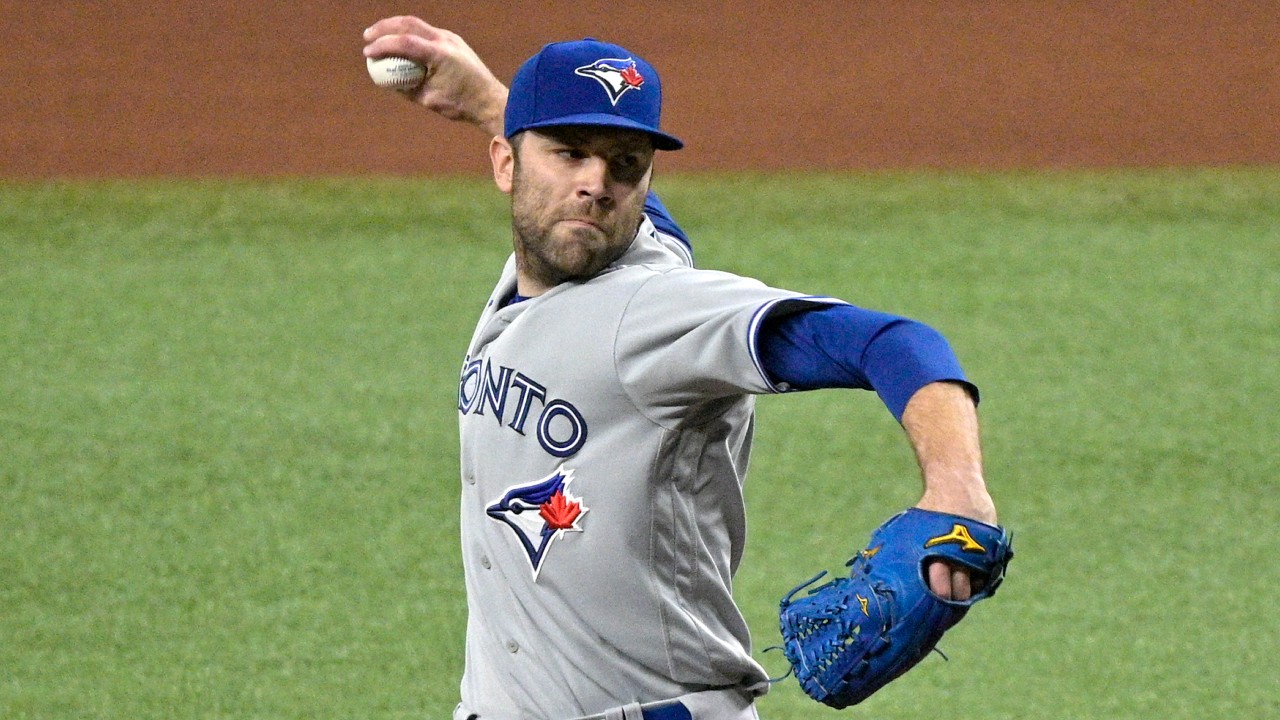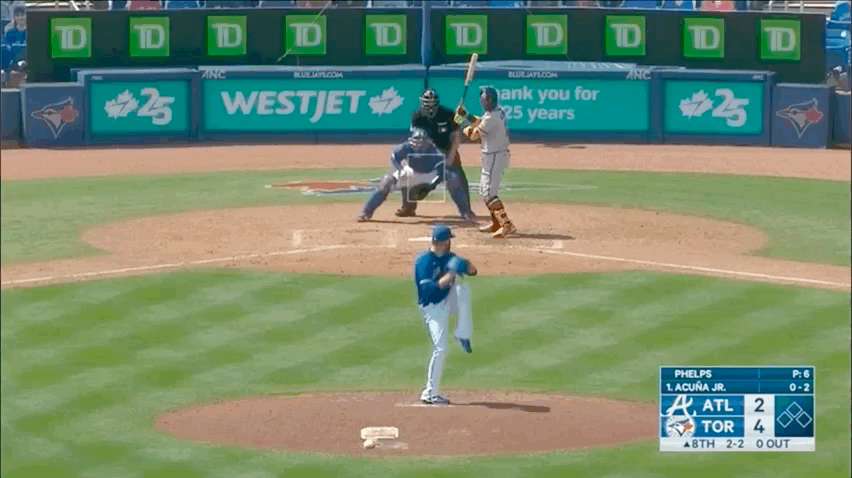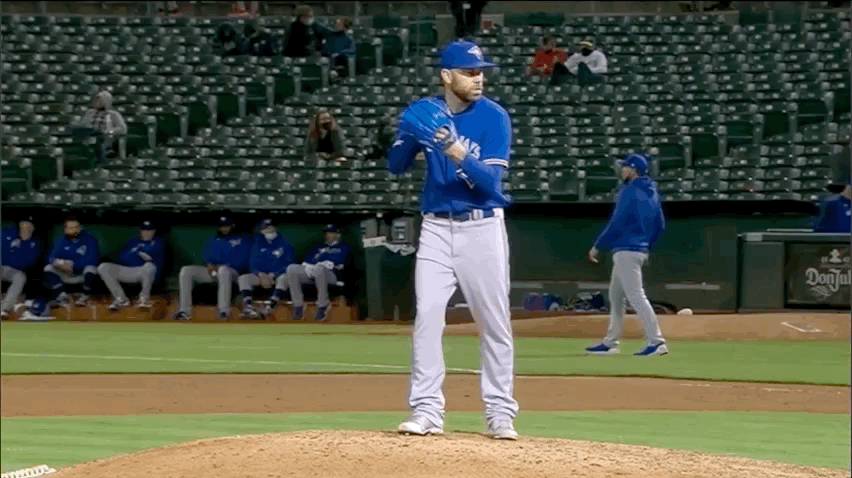
Perhaps you remember David Phelps. Perhaps you remember the important bridge role the right-hander played in the 2021 Toronto Blue Jays bullpen, often protecting slim, seventh-inning leads and allowing only a run on eight hits — seven singles and a double — over his first 11 appearances.
Perhaps you remember his 15 strikeouts against only four walks; his control and command of four pitches; his 30.4 per cent whiff rate on a four-seamer that missed bats in the zone.
Perhaps you remember him taking the mound on a sunny Sunday afternoon in Dunedin, Fla., last May — only 16 hours after pitching a clean inning the night prior — to face the heart of the eventual World Series champion’s order with a two-run, eighth-inning lead. Perhaps you remember him striking out the side.

You didn’t know it at the time, but that curveball to Ozzie Albies was the final pitch you’d see him throw all season.
Phelps didn’t know it, either. He felt incredible. Like he was getting stronger with every outing. Coming off an absurdly hard-luck finish to his 2020, the 10-year MLB veteran was off to the best start of his career.
But then he was given the ball for the eighth inning of a game in Oakland three days later. Everything was normal from getting up in the bullpen, to taking the mound, to working through six of his eight warm-up pitches before facing a hitter.
As he released his seventh pitch — a cutter — Phelps immediately felt a sharp, stabbing sensation up in his armpit. He removed his glove and started pacing the mound, trying to hide the pain. Phelps’ catcher, Danny Jansen, immediately came sprinting out.

“Jano was like, ‘What the heck just happened?’ I said, ‘I think I just blew out my shoulder,’” Phelps remembers. “That’s what I thought walking off the field. Labrum, rotator cuff. I’m thinking, ‘I’m going to have to get surgery just so I can play golf now that my career is over.’ I thought I was done. It’s crazy the thoughts that go through your head.”
The thing is, an initial MRI of Phelps’ shoulder didn’t reveal damage consistent with the symptoms he was experiencing, which led to a second imaging days later of a larger area including his lateral chest wall. That’s when they saw it.
At the time, the Blue Jays announced Phelps’ injury as a latissimus dorsi strain, which is one way of describing it. Another, more accurate way would’ve been to call it a rupture. As in Phelps tore the muscle completely off his shoulder. It had retracted four centimetres from his arm. Before a surgeon could even reattach the loose lat to its proper place on the humerus with a series of sutures and metallic anchors, they’d first have to root around inside Phelps through an incision near the pitcher’s armpit just to locate the damn thing.
That was, assuming he’d undergo the surgery. While lat strains are relatively common among MLB pitchers, complete tears occur much less frequently. Physicians typically see it in Olympic weightlifters and rock climbers. And while it’s possible to treat a lat rupture nonoperatively and return to some sports, it’s extremely unlikely an athlete would ever be able to accurately throw a baseball 93-m.p.h. again without a procedure.
The decision Phelps was presented with in consultation with several specialists — including renowned MLB surgeons Dr. Anthony Romeo, Dr. David Altcheck, and Dr. James Andrews — was either to get surgery and have a chance of returning to an MLB mound or not get surgery and retire.
Complicating Phelps’ thought process was the relative lack of MLB pitchers who have had injuries like his surgically repaired and returned to elite form. Jake Peavy was the first, undergoing a then-experimental lat revision operation — the first-of-its-kind procedure was performed by Dr. Romeo, who invented a kit of tools to complete it — in 2010. He went on to pitch a half-dozen more seasons in the majors.
But in consulting with Dr. Romeo, Phelps learned the procedure had only been performed on a small handful of major-leaguers since — and not all of them had made it back. Oakland A’s reliever Fernando Rodriguez underwent it as a 32-year-old in 2016 and never pitched in the big-leagues again. Phelps was turning 35. It was a risk. To say nothing of the substantial rehabilitation he’d undergo before even attempting a comeback.
“I had to really think about it. Like, ‘Do I have a year-long rehab in me at this point?’” Phelps says. “I’m thinking about how later in spring training, during the first month of the season, my kids are in school — you’re getting to the point where you’re starting to miss a lot of really big things. So, I spent some time praying about it, doing some soul searching. Asking myself, ‘Is this what I still feel like I’m called to do? Am I still enjoying it?’”
Ultimately, Phelps found the answers he was looking for and underwent lat revision surgery performed by Dr. Romeo on May 24.
If there’s a silver lining, it was that Phelps at least knew what lay ahead. He had Tommy John surgery when he was with the Seattle Mariners in 2018 and maintained a strong relationship with the physical therapist — Dr. Tara Lynch-Stempfer in Wexford, Pa., — who’d helped him complete that lengthy rehab. She was one of the first people Phelps texted after he decided to get the surgery and try to keep pitching: “Hey, do you have another year-long rehab in you?”
Working with Lynch-Stempfer also meant Phelps got to spend the summer at his home outside Pittsburgh with his wife, Maria, and their four children: Adeline, nine, Eloise, eight, Jackson, six, and Genevieve, two. After being completely isolated from them for months during the pandemic-shortened 2020 season, Phelps had the opposite experience, attending rehabilitation sessions early in the morning before getting to spend the rest of the day with his family.
He got to watch Adeline play softball. He coached Jackson’s baseball team. He watched all three of his eldest play soccer in the fall. The entire family got to take a Florida vacation during the summer for the first time since Phelps and Maria were married. It helped ease the stress he was feeling about deciding to give professional baseball one more shot the following spring.
“Rehab’s long; it’s frustrating; it’s grueling. It’s not fun laying on a table and having someone move your arm just an inch, just to get it moving again,” Phelps says. “But being able to be with my wife and kids through this, having their happiness of dad being home is what lifted me up through some of my harder days — it was everything.”
As a free agent this winter, Phelps and his representation spoke to a handful of clubs. But for a 35-year-old reliever coming off a significant injury and still rehabbing from an uncommon procedure, a guaranteed roster spot was always going to be difficult to come by.
That left Phelps to ponder what he’d value on a minor-league deal — location, opportunity, environment — and those considerations kept leading him back to the Blue Jays.
He valued how honest and forthright his relationship had been with Toronto’s coaching staff during his two stints in the organization; how pitching coaches Pete Walker and Matt Buschmann helped him get the most out of his stuff even when he wasn’t feeling his best coming off Tommy John; how much trust was built over time. How much fun he had in a young, energetic clubhouse where he felt like as much of a dad as a teammate and could help mentor emerging MLBers, paying forward the lessons New York Yankees veterans once taught him.
He kept coming back to how the Blue Jays treated him following the lat injury. The players, coaches, and staff who periodically checked in with him while he was watching the team from afar. The way the club’s medical director, Andrew Pipkin, worked closely with Lynch-Stempfer throughout his rehab even though Phelps was done for the season and headed for free agency. The relationships he built with individuals at various levels of the organization dating back to when he was finishing his Tommy John recovery in 2019.
Phelps decided if he was going to attempt a non-roster comeback with anyone, he wanted it to be with the Blue Jays. Fortunately, the interest was mutual. Late this November, Phelps agreed to terms with the club on a minor-league deal that could pay him a $1.75-million salary if he earns a roster spot during spring training, with the chance to earn an additional $1.75-milllion in performance bonuses.
“Is this an insanely talented team? Absolutely. Is this a team that has the ability to win a World Series? I fully believe so. But I also wanted to be here because of the relationships and the quality of the individuals in the organization. From top to bottom, I’ve had nothing but an amazing experience,” he says. “I’ve been around. I’ve played in seven different home ballparks. And when I think about the people I’ve played with throughout the entire league, the group in Toronto is special. They have the ability to do something very special.”
And so, for the first time in over a decade, Phelps will report to spring training needing to win himself a job. That won’t be easy on an established team with a crowded bullpen and aspirations of contention. But the competition and steep hill that awaits is the last thing Phelps is worrying about going into his 15th professional season.
“My goal throughout this entire rehab has been health. That doesn’t change,” he says. “Because when I’ve been healthy, outside of a blip here or there, I’ve been able to have success and get people out. So, if I can get to that point coming into spring training, and do what I’m able to do, I think I’ll be able to bring value to a ball club.”
More than seven months after throwing that cutter in Oakland, Phelps can feel himself getting closer to being that guy again. He finally got back on a mound to begin a throwing progression just before Christmas and has completed nearly a dozen mound sessions since, gradually increasing volume and intensity.
He recently shifted his work to FullReps Training Center in Camp Hill, Pa., — fellow Blue Jays reliever Tim Mayza trains there, too — where he’ll have access to Rapsodo data and high-speed video while he builds himself back up. During a 35-pitch bullpen in mid-January, Phelps began spinning curveballs and cutters that came out just the way he wanted them to.
Phelps’ off-season program will culminate with a pair of high-volume, live batting practice sessions in the days prior to him reporting to spring training in Dunedin. If all continues to go well, he’ll use the first week of camp to deload from his rehab and throwing progression before beginning to ramp up for the regular season on the same schedule as the rest of Toronto’s pitching staff.
How his reattached lat responds to increased stress will determine where things go from there. A lat revision isn’t a common procedure; and a return to MLB competition following one isn’t a common occurrence. It’ll be a fluid process and Phelps will have to manage some soreness and discomfort as he returns to in-game stress and intensity. But he knows that. Overcoming a year-long rehab’s nothing new for him. Nothing he hasn’t done before. And nothing that’ll keep him from giving it one more shot.
“We’ve been meticulous with hitting all the rehab steps along the way. It’s been a long one. But I’ve been through a throwing progression like this before. And I learned what not to do the first time around,” Phelps says. “As much as it’s a physical rehab, a lot of it’s mental as well. I’ve talked to countless guys who’ve rehabbed over the years, and that mental hurdle’s usually the last one. And a lot of times it doesn’t come until you’re facing hitters. Until you get your adrenaline going and you can finally start to let stuff go.
“But as of right now, I’m optimistic that I’ll be in a good spot at the start of spring training. Obviously, with rehab, you never know. But the way the ball’s coming out, the way I’m able to command the ball right now, I’m pretty excited.”
After rare injury and surgery, Phelps eager to win job in Blue Jays bullpen
Source: Pinas Ko Mahal

0 Mga Komento